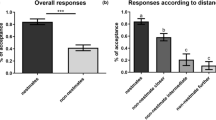Abstract
The host-foraging behavior of female entomophagous parasitoids is commonly modified by positive associative learning. Typically, a rewarding experience (e.g., successful oviposition in a host) increases a female's foraging effort in a host microhabitat of the type associated with that experience. Less well understood are the effects of unrewarding experiences (i.e., unsuccessful foraging). The influence of unrewarding experience on microhabitat choice and residence time within a microhabitat was examined for the eucoilid parasitoid,Leptopilina heterotoma, in laboratory and greenhouse assays. As determined previously, females which oviposited successfully in either of two microhabitat types (fermenting apple or decaying mushroom) strongly preferred to forage subsequently on that microhabitat type. However, failure to find hosts in the formerly rewarding microhabitat caused females to reverse their preference in favor of a novel microhabitat type. The effect, though striking, was transient: within 1–2 h, the original learned preference was nearly fully restored. Similar effects of unrewarding experiences were observed with respect to the length of time spent foraging in a microhabitat. As determined previously, oviposition experience in a particular microhabitat type increased the time spent foraging in a patch of that microhabitat type. However, failure to find hosts in the patch caused the time a wasp spent in the next unoccupied patch of that type to decrease to almost nothing. In addition, there was a tendency for an unrewarding experience on a formerly rewarding microhabitat type to extend the time spent in a patch of a novel type. The function of the observed effects of unrewarding experiences is discussed.
Similar content being viewed by others
References
Abramson, C. I. (1986). Aversive conditioning in honey bees (Apis mellifera).J. Comp. Psychol. 100: 108–116.
Bernays, E. A. (1993). Aversion learning and feeding. In Papaj, D. R., and Lewis, A. C. (eds.),Insect Learning: Ecological and Evolutionary Perspectives, Chapman and Hall, New York, pp. 1–17.
Dicke, M., van Lenteren, J. C., Boskamp, G. J. F., and van Voorst, R. (1985). Intensification and prolongation of host searching inLeptopilina heterotoma (Thomson) (Hymenoptera: Eucoilidae) through a kairomone produced byDrosophila melanogaster.J. Chem. Ecol. 11: 125–136.
Heinrich, B. (1979). “Majoring” and “minoring” by foraging bumble bees,Bombus vagans: An experimental analysis.Ecology 60: 245–255.
Lewis, W. J., and Tumlinson, J. H. (1988). Host detection by chemically mediated associative learning in a parasitic wasp.Nature 331: 257–259.
Mangel, M. (1993). Motivation, learning and motivated learning. In Papaj, D. R., and Lewis, A. C. (eds.),Insect Learning: Ecological and Evolutionary Perspectives, Chapman and Hall, New York, pp. 158–173.
Menzel, R. (1983). Neurobiology of learning and memory: The honeybee as a model system.Naturwissenschaften 70: 504–511.
Menzel, R., Greggers, U., and Hammer, M. (1993). Functional organization of appetitive learning and memory in a generalist pollinator, the honey bee. In Papaj, D. R., and Lewis, A. C. (eds.),Insect Learning: Ecological and Evolutionary Perspectives, Chapman and Hall, New York, pp. 79–125.
Papaj, D. R. (1986). Conditioning of leaf-shape discrimination by chemical cues in the butterfly,Battus philenor. Anim. Behav. 34: 1281–1288.
Papaj, D. R. (1990). Interference with learning in pipevine swallowtail butterflies: Behavioural constraint or possible adaptation?Symp. Biol. Hung. 39: 89–101.
Papaj, D. R., and Vet, L. E. M. (1990). Odor learning and foraging success in the parasitoid,Leptopilina heterotoma.J. Chem. Ecol. 16: 3137–3150.
Rausher, M. D. (1978). Search image for leaf shape in a butterfly.Science 200: 1071–1073.
Real, L. (1991). Animal choice behavior and the evolution of cognitive architecture.Science 253: 980–986.
SAS. (1991).SAS/STAT User's Guide, Release 6.03 Edition, SAS Institute Inc., Cary, NC.
Smith, B. H., Abramson, C. I., and Tobin, T. R. (1991). Conditional withholding of proboscis extension in honey bees (Apis mellifera) during discriminative punishment.J. Comp. Psychol. 105: 345–356.
Staddon, J. E. R. (1983).Adaptive Behavior and Learning, Cambridge University Press, Cambridge.
Tumlinson, J. H., Lewis, W. J., and Vet, L. E. M. (1993). How parasitic wasps find their hosts.Sci. Am. 266: 100–106.
Turlings, T. C. J., Tumlinson, J. H., Lewis, W. J., and Vet, L. E. M. (1989). Beneficial arthropod behavior mediated by airborne semiochemicals. VIII. Learning of host-related odors induced by a brief contact experience with host by-products inCotesia marginiventris (Cresson), a generalist larval parasitoid.J. Insect Behav. 2: 217–225.
Turlings, T. C. J., Wäckers, F. L., Vet, L. E. M., Lewis, W. J., and Tumlinson, J. H. (1993). Learning of host-finding cues by hymenopterous parasitoids. In Papaj, D. R., and Lewis, A. C. (eds.),Insect Learning: Ecological and Evolutionary Perspectives, Chapman and Hall, New York, pp. 51–78.
Vet, L. E. M. (1988). The influence of learning on habitat location and acceptance by parasitoids.Les Coll. l'INRA 48: 29–34.
Vet, L. E. M., and Dicke, M. (1992). Ecology of infochemical use by natural enemies in a tritrophic context.Annu. Rev. Entomol. 37: 141–172.
Vet, L. E. M., and Groenewold, L. (1990). Learning in insect parasitoids: The role of kairomones.J. Chem. Ecol. 16: 3119–3136.
Vet, L. E. M., and Schoonman, G. (1988). The influence of previous foraging experience in microhabitat acceptance inLeptopilina heterotoma.J. Insect Behav. 1: 387–392.
Visser, M. E., van Alphen, J. J. M., and Nell, H. W. (1990). Adaptive superparasitism and patch time allocation in solitary parasitoids: The influence of the number of parasitoids depleting a patch.Behaviour 114: 21–36.
Waage, J. K. (1978). Foraging for patchily distributed hosts by the parasitoidNemeritis canescens.J. Anim. Ecol. 48: 353–371.
Wcislo, W. T. (1993). Attraction and learning in mate-finding by solitary bees,Lasioglossum (Dialictus) figueresi Wcislo andNomia triangulifera Vachal (Hymenoptera: Halictidae).Behav. Ecol. Sociobiol. 31: 139–148.
Author information
Authors and Affiliations
Rights and permissions
About this article
Cite this article
Papaj, D.R., Snellen, H., Swaans, K. et al. Unrewarding experiences and their effect on foraging in the parasitic waspLeptopilina heterotoma (Hymenoptera: Eucoilidae). J Insect Behav 7, 465–481 (1994). https://doi.org/10.1007/BF02025444
Accepted:
Issue Date:
DOI: https://doi.org/10.1007/BF02025444




